
 Judy's
only pairing with Fred Astaire came about almost by accident.
In 1946 songwriter Irving Berlin first approached 20th Century-Fox
about making a film to be titled "Easter Parade" and
to build the film around a catalog of his songs, as well as
new songs he would write specifically for the film. In 1938
20th Century-Fox had done such a great job with another Berlin-based
musical starring Alice Faye entitled Alexander's Ragtime
Band, that makes sense that Berlin would first approach
Fox. However, they balked at his request for $600,000 plus a
percentage of the film's profits. He ended up getting the $600,000
but no percentage. Judy's
only pairing with Fred Astaire came about almost by accident.
In 1946 songwriter Irving Berlin first approached 20th Century-Fox
about making a film to be titled "Easter Parade" and
to build the film around a catalog of his songs, as well as
new songs he would write specifically for the film. In 1938
20th Century-Fox had done such a great job with another Berlin-based
musical starring Alice Faye entitled Alexander's Ragtime
Band, that makes sense that Berlin would first approach
Fox. However, they balked at his request for $600,000 plus a
percentage of the film's profits. He ended up getting the $600,000
but no percentage.
Ace MGM musicals producer Arthur Freed jumped at the chance
to do a film with Berlin. Freed had already begun his series
of musicals based on a particular composer's or songwriting
team's catalogs of music with the release of the Jerome Kern
bio-pic Till The Clouds Roll By in 1946. In the same
year that Easter Parade was released (1948) Freed also
released another biographical film based on a catalog of song
hits, Words & Music (1948), this time from the
catalog of Richard Rodgers and Lorenz Hart. Although Freed would
abandon the "bio-pic" idea, he continued to produce
films based on song catalogs, culminating in the legendary Singin'
In The Rain in 1952 and The Band Wagon in 1953.
With a quick pre-approval of Berlin's shrewd money request from
MGM Studio Chief Louis B. Mayer, Freed began pre-production
on Easter Parade utilizing all the talents of his famous
"Freed Unit".
 Freed assigned Frances Goodrich and Albert Hackett to write
the script for Easter Parade. They had recently rescued
the unworkable script for troubled The
Pirate, which was currently in production starring
Judy and Gene Kelly. The
Pirate's director, Vincente Minnelli, was assigned as director
for Easter Parade. MGM musical guru Roger Edens began
the process of going through Berlin's song catalog to choose
songs that best suited the story and stars, while Berlin began
writing the new songs for the film. In February 1947, columnist
Louella Parsons reported the Easter Parade was MGM's
next big musical production, to star Judy, Gene Kelly, Frank
Sinatra, Kathryn Grayson, and Red Skelton. Freed assigned Frances Goodrich and Albert Hackett to write
the script for Easter Parade. They had recently rescued
the unworkable script for troubled The
Pirate, which was currently in production starring
Judy and Gene Kelly. The
Pirate's director, Vincente Minnelli, was assigned as director
for Easter Parade. MGM musical guru Roger Edens began
the process of going through Berlin's song catalog to choose
songs that best suited the story and stars, while Berlin began
writing the new songs for the film. In February 1947, columnist
Louella Parsons reported the Easter Parade was MGM's
next big musical production, to star Judy, Gene Kelly, Frank
Sinatra, Kathryn Grayson, and Red Skelton.
MGM's biggest musical star, Judy Garland, was the logical choice
to star. Even though Berlin first approached Fox, Arthur Freed
later stated that "the reason I got Irving to agree to
do Easter Parade was on account of Judy." And
this was probably true. All of the top musical talent of the
day, whether it be songwriters, composers, directors, or performers
- they all wanted to work with Judy Garland. Such was her reputation
for having a talent approaching genius. If fact, the song "It
Only Happens When I Dance With You" came about because
of Judy. As Judy told the story years later: "The photographer
asked us to stand in a dancing position. I quipped, 'Maybe this
will inspire one of the new songs.' Irving laughed and said
'Maybe,' Then, as I was leaving, he slipped a small piece of
paper into my hand, saying, 'Don't show this to anyone yet.'
When I looked at it, I read the words, 'It only happens when
I dance with you'. I've always considered this my very own beloved
melody."
 As production got under way in the fall of 1947, a series of
obstacles popped up. On September 18, 1947, director Vincente
Minnelli was taken off the film and replaced with Charles Walters.
Minnelli was married to Garland at this time and their working
together on The
Pirate had put a huge strain on their marriage. Judy's therapist
suggested that they not work together so soon.
As production got under way in the fall of 1947, a series of
obstacles popped up. On September 18, 1947, director Vincente
Minnelli was taken off the film and replaced with Charles Walters.
Minnelli was married to Garland at this time and their working
together on The
Pirate had put a huge strain on their marriage. Judy's therapist
suggested that they not work together so soon.
Judy's frail condition after completing The
Pirate in late July 1947 had led her to make an unpublicized
suicide attempt. She was admitted to the Las Campanas sanitarium
in California, then spent a few weeks at the Austen Riggs Center
in Stockbridge, Massachusetts and was back home on August 20th.
Just a short month later, on September 22nd, she began music
rehearsals for Easter Parade with Gene Kelly, including
the new Berlin song "A Couple Of Swells".
Then, on October 13th Gene Kelly broke his ankle either playing
softball, volleyball, or baseball - depending on which book
you read. Kelly himself later said "I told [MGM studio
boss Louis B.] Mayer I'd been rehearsing a rather complicated
dance step, because I didn't think he'd respond too well to
the truth. I said, 'Why don't you give Fred Astaire a ring?'"
A call went out to the then nominally retired Fred Astaire.
Per Kelly: "Fred called me back. He said, 'Are you sure
you don't want to do this picture? It's a good picture.' I said,
'Fred, you'll be doing me a favor, 'cause they think I'm a bum.
L.B. Mayer thinks I broke my leg on purpose. Please
do it!"
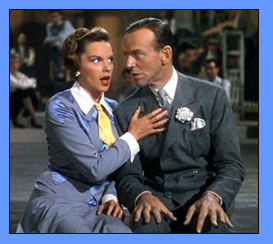 Astaire was delighted at the chance of working with Garland,
and quickly accepted, reporting to work on October 16th, just
3 days after Kelly broke his ankle. This move would begin a
new 10 year association between Astaire and MGM resulting in
some of Astaire's (and MGM's) best musical moments. Astaire was delighted at the chance of working with Garland,
and quickly accepted, reporting to work on October 16th, just
3 days after Kelly broke his ankle. This move would begin a
new 10 year association between Astaire and MGM resulting in
some of Astaire's (and MGM's) best musical moments.
Another accident ended up helping the film. Cyd Charisse was
slated to play Astaire's ex-dancing partner Nadine. But Cyd
tore a ligament in her foot and had to be taken off the film.
Ann Miller, a personal favorite of MGM studio boss Louis B.
Mayer, auditioned for the role. Mayer told her that he couldn't
help her with her audition, she would have to prove herself
on her own. Ann got the role, beginning a successful new phase
of her career becoming known as "tops in taps".
With the cast in place (the Sinatra, Grayson, & Skelton
roles had long since vanished), the first item of business was
the script. When Charles Walters came on board as director,
he felt the script was terrible. The Kelly/Astaire character
was a real heel. This was possibly due to Kelly's Broadway star-making
hit "Pal Joey" and his film debut opposite Judy in
For Me
And My Gal (1942) in which he played similar "heel"
characters to great effect. Sidney Sheldon was brought in to
make rewrites. He tightened up the story and helped make it
one of the best written musicals MGM ever made. The story is
a slight departure from the average MGM musical fare of the
day in that, although it's about musical performers, the story
is more concerned with the love lives of the principal characters.
In this case not just two or three, but FOUR people who's lives
are intertwined romantically. Judy loves Fred; Fred loves Ann;
Ann loves Peter; Peter loves Judy. The dialog is crisp and believable,
and a definite improvement over most musicals. It's this storyline,
peppered with the cavalcade of one musical showstopper after
another, that keeps the audiences interest and makes Easter
Parade one of the greatest of all MGM Musicals.
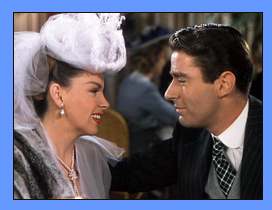
Judy
was in wonderful spirits while making Easter Parade.
In fact, during the early days of production on Easter Parade,
she was doing double-duty byalso filming extensive retakes
for the trouble-plagued The
Pirate. She relished working with Fred Astaire
who later remembered "Judy's the greatest entertainer who
ever lived - or probably ever will live...an amazing girl. She
could do things - anything - without rehearsing and
come off perfectly. She could learn faster, do everything better
than most people. It was one of the greatest thrills to work
with her."
Filming went along smoothly and without a hitch. Easter
Parade was completed on March 12th, 1948 and would go on
to become MGM's biggest hit of 1948, grossing over 6 million
dollars in it's initial release. As far as Judy's career is
concerned, Easter Parade was the last big-budget MGM
Musical she would make for the studio (aside from her guest
appearance in Words & Music, also in 1948). Her
films after Easter Parade, while all huge hits at the
box office and with the public, were of a smaller scale and
were produced not by the Freed Unit (where most of the big budget
MGM musicals were made) but by the Joe Pasternak Unit, a unit
known for making reliable small budget musicals. This
was due to Judy's increasing problems with overwork, insecurities,
and her growing addiction to several medications.
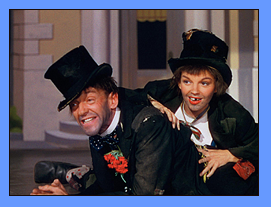 The
pairing of Garland & Astaire was such a success that MGM
immediately planned to team them again in The Barkleys of
Broadway, written by the witty team of
Betty Comden & Adolph Green. However, after the strain of
making The
Pirate, Easter Parade, and her guest
appearance in Words & Music (all three released
in 1948) Judy was unfit to endure another strenuous high profile
production. Beginning on June 14, 1948 she was in rehearsals
for Barkleys but missed so many days due to illness
that MGM was forced to remove her from the film on July 18,
1948. She was replaced Ginger Rogers and put on suspension. The
pairing of Garland & Astaire was such a success that MGM
immediately planned to team them again in The Barkleys of
Broadway, written by the witty team of
Betty Comden & Adolph Green. However, after the strain of
making The
Pirate, Easter Parade, and her guest
appearance in Words & Music (all three released
in 1948) Judy was unfit to endure another strenuous high profile
production. Beginning on June 14, 1948 she was in rehearsals
for Barkleys but missed so many days due to illness
that MGM was forced to remove her from the film on July 18,
1948. She was replaced Ginger Rogers and put on suspension.
It wasn't until May, 1950 that MGM again tried to team Judy
with Astaire, this time for Royal Wedding. Alas, it
was not to be. During the interim, Judy had been on an emotional
and physical roller coaster. She had bounced back to film a
second guest spot for Words & Music in September
of 1948, then in the winter of 1948/1949 she quickly completed
In The
Good Old Summertime (released in 1949) for the Pasternak
Unit.
In March of 1949, Judy began work on Annie
Get Your Gun - the Broadway mega-hit that had been
purchased at great expense solely for her. But that production
was plagued from the start. Busby Berkeley's awful direction,
Judy's lack of sufficient rest between productions, and a myriad
of other problems conspired against the film. Judy faltered
and was suspended again on May 10, 1949. She entered Peter Brent
Brigham Hospital in Boston to cure her dependency on prescription
medications and recover from a complete physical collapse. After
a few months she was well enough to return to MGM. She then
went into rehearsals for Summer
Stock and finally (and under great emotional strain) completed
that film in March of 1950.
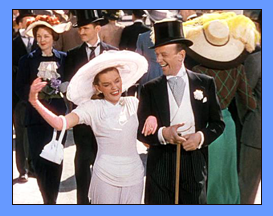 Judy then went to Carmel for a planned six month rest, but was
lured back by MGM to replace the pregnant June Allyson and co-star
once again with Fred Astaire in Royal Wedding. It was
too much too soon. Judy endured another physical and mental
collapse, and was suspended on June 17th, 1950. Two days later
she attempted suicide again with a light scratch to her throat.
More a cry for help than an actual suicide attempt, the act
was leaked to the press and made international headlines. Rather
than alienating her, the faux suicide attempt did the reverse
by endearing her even more to her fans. On September 29, 1950
Judy was granted her request for a release from her MGM contract.
Free from the constraints of the studio system, Judy would soon
begin the legendary "concert years" phase of her career.
Judy then went to Carmel for a planned six month rest, but was
lured back by MGM to replace the pregnant June Allyson and co-star
once again with Fred Astaire in Royal Wedding. It was
too much too soon. Judy endured another physical and mental
collapse, and was suspended on June 17th, 1950. Two days later
she attempted suicide again with a light scratch to her throat.
More a cry for help than an actual suicide attempt, the act
was leaked to the press and made international headlines. Rather
than alienating her, the faux suicide attempt did the reverse
by endearing her even more to her fans. On September 29, 1950
Judy was granted her request for a release from her MGM contract.
Free from the constraints of the studio system, Judy would soon
begin the legendary "concert years" phase of her career.
So, even though the pairing with Fred Astaire was tried and
failed, Easter Parade will always remain as one of
Judy and Fred's greatest films - and one of the great classics
of the golden age of movie musicals.
top of page
|


| DATE |
EVENT |
| 09/23/47 |
Preproduction
begins on Easter Parade with Gene Kelly as Judy's
lead, and Cyd Charisse as "Nadine". |
| 09/23/47 |
Music rehearsal. |
| 09/25/47 |
Music rehearsal. |
| 09/26/47 |
First rehearsal of "A Couple Of
Swells". |
| 09/29
- 09/30/47 |
Judy was out sick. |
| 10/01/47 |
"Swells" rehearsal. |
| 10/02/47 |
"Swells" rehearsal. |
| 10/03/47 |
"Swells" rehearsal. |
| 10/06/47 |
"Swells" rehearsal. |
| 10/07/47 |
First rehearsal of "Mr. Monotony". |
| 10/07/47 |
"Swells" & "Mr.
Monotony" rehearsal. |
| 10/08/47 |
"Swells" & "Mr.
Monotony" rehearsal. |
| 10/09/47 |
"Swells" rehearsal. |
| 10/13/47 |
"Mr. Monotony" rehearsal.
Also - Gene Kelly brakes his ankle, forcing him to bow out of
the film. Fred Astaire is called out of his self-imposed "semi-retirement"
to take Kelly's place. |
| 10/16/47 |
Fred Astaire joins the cast. Judy is
rehearsing "Mr. Monotony" on this date. |
| 10/20/47 |
"Swells" rehearsal. Presumably
the first one with Fred Astaire taking over for Gene Kelly. |
| 10/22/47 |
Judy begins filming retakes for The
Pirate after previews necessitated some major changes.
Judy would shuttle back and forth between The
Pirate and Easter Parade through December 19,
1947. |
| 10/23
- 10/25/47 |
Judy was out sick. |
| 10/26/47 |
Judy participates with other stars
to protest against the House of un-American Activities Committee,
via the radio show "Hollywood Fights Back". |
| 10/27/47 |
The
Pirate retakes. |
| 10/28/47 |
"Swells" rehearsal. |
| 10/29/47 |
"Strut" rehearsal and orchestration
of "Mr. Monotony". |
| 10/30/47 |
Rehearsed "Strut," "Drum,"
& "Mr. Monotony". |
| 10/31
& 11/01/47 |
Judy was out sick. |
| 11/03/47 |
Wardrobe tests. |
| 11/04/47 |
"Mr. Monotony" rehearsal. |
| 11/05/47 |
"Mr. Monotony" rehearsal. |
| 11/06/47 |
Rehearsed "A Fella With An Umbrella,"
"A Couple Of Swells," & "Mr. Monotony". |
| 11/07/47 |
Rehearsed "A Fella With An Umbrella,"
"A Couple Of Swells," & "Ragtime Violin". |
| 11/11/47 |
Wardrobe and makeup tests. |
| 11/12/47 |
First recording session for Easter
Parade. Judy records "I Want To Go Back To Michigan
(Down On The Farm)," & "Mr. Monotony". |
| 11/13/47 |
Recording session. Judy and fred record
"A Couple Of Swells". Judy also rehearses "It Only
Happens When I Dance With You" and "A Fella With An
Umbrella". |
| 11/14/47 |
Rehearsed (presumably the performing
of) "Mr. Monotony" & "Michigan". |
| 11/15/47 |
Judy's final recording session for
Decca Records. |
| 11/17/47 |
Recording session: "Vaudeville
Montage" with Fred Astaire (Medley consists of: "I Love
A Piano," "Snookey Ookums," "The Ragtime Violin,"
& "When The Midnights Choo-Choo Leaves For Alabam'). |
| 11/18/47 |
More retakes for The
Pirate, "interior Manuela's bedroom". After
these, Judy posed for wardrobe tests for Easter Parade,
wearing the dress for the "bloopface" scene is which
she walks ahead of Fred Astaire to try and get passers-by to look
at her. One of Judy's funniest moments on film! |
| 11/19/47 |
Rehearsed "A Fella With An Umbrella"
and "Mr. Monotony". |
| 11/21
& 22/47 |
Filming of "Mr. Monotony".
This number is cut from the film, but the footage survives and
was the most talked about sequence in the 1994 theatrical release
That's Entertainment III. Judy is wearing the outfit
with which she would later become identified with, the top half
of a tuxedo. She wore the outfit to great effect two years later
in her final film (and footage shot for) MGM: Summer Stock
(1950). |
| 11/24/47 |
Judy was out sick. |
| 11/25/47 |
Rehearsals and fitting. Rehearsed the
"Interior Millinery Shop" scene and the song "A
Fella With An Umbrella". |
| 11/26/47 |
Rehearsed "A Fella With An Umbrella"
and "It Only Happens When I Dance With You". |
| 11/28
- 29/47 |
Judy was not on call. |
| 12/01/47 |
Judy had a call for The
Pirate retakes, but called in sick. |
| 12/02/47 |
The
Pirate work. Rehearsal of the newly revised "Mack
The Black" number. |
| 12/03
- 04/47 |
Filming: "Interior Globe Theater"
- "A Couple Of Swells". |
| 12/05/47 |
Filming: The "I Love A Piano"
and "Snookey Ookums" parts of the "Vaudeville Montage". |
| 12/06/47 |
Filming: The "The Ragtime Violin"
part of the "Vaudeville Montage". |
| 12/08/47 |
Filming: "Interior Pastini's Cafe". |
| 12/09/47 |
Judy had a 9:00 a.m. call to film "Interior
Pastini's Cafe" (including the song "I Want To Go Back
To Michigan". She notified the studio that she would not
be able to work until after lunch. She arrived on the set at 1:00
p.m. to film "Interior Rehearsal Hall". The company
was dismissed at 5:55 p.m. |
| 12/10/47 |
Filming: "Interior Michael's"
and "Interior Pastini's Cafe" (the "Michigan"
number). |
| 12/11/47 |
More The
Pirate retakes. The Assistant Director of that film noted
that Judy reported for recording at 1:30 p.m. and rehearsed until
3:30 p.m. at which time she said that she had a temperature. Producer
Arthur Freed was on the set and had a doctor called. A "Dr.
Jones" came to the set and found that Judy had no temperature,
but advised that she should not work the rest of the day, nor
the following day. |
| 12/12/47 |
Judy was out sick. |
| 12/13/47 |
Judy was not on call. |
| 12/15/47 |
Judy recorded the new, improved version
of "Mack The Black" for The
Pirate. This is the version that we see in the film today.
Judging from the surviving audio outtakes (see The
Pirate page in the Rhino Records section) we can see
why it was replaced. The outtake footage of the original sequence
no longer exists. |
| 12/16
- 18/47 |
The
Pirate retakes: Rehearsed "Mack The Black". |
| 12/19/47 |
Final The
Pirate retakes. Judy filmed retakes of "Interior
Manuela's Balcony". The
Pirate was finally finished, and would be released prior
to Easter Parade on June 11, 1948. |
| 12/20/47 |
Filmed "Interior Amsterdam Theater
Stage" ("When The Midnight Choo-Choo Leaves For Alabam")
as well as "Interior Amsterdam Back Stage" (probably
the scene where Nadine [Ann Miller] confronts Don and Hannah after
their audition). |
| 12/22
& 23/47 |
Filming includes "Exterior Drug
Store" and "Exterior Alleyway (Amsterdam Theater)". |
| 12/24
- 27/47 |
Judy was out sick. |
| 12/29/47 |
Filmed "Interior Brevoort Restaurant"
with Peter Lawford. |
| 12/30/47 |
Filmed "Interior Dress Shop"
and "Interior Hannah's Hotel Suite". |
| 12/31/47 |
Judy was out sick. |
| 01/02/48 |
Filmed the scene when Judy and Fred
look at the calendar and discover that they'll be back in New
York in time for the Easter Parade. |
| 01/03/48 |
Filmed "Interior Hannah's Hotel
Suite" and "Interior Don's Living Room". |
| 01/05/48 |
Filmed "Interior Don's Living
Room" and "Exterior Hannah's Dressing Room". |
| 01/06/48 |
Judy was out sick. |
| 01/07/48 |
Recording session: "A Fella With
An Umbrella" (Judy and Peter Lawford), Judy's reprise of
"It Only Happens When I Dance With You," and "Better
Luck Next Time". The complete, previously unreleased version
of "Better Luck Next Time," which is quite beautiful,
is on the Rhino Records soundtrack
CD. |
| 01/08/48 |
Filmed "Interior Don's Living
Room". On this date, the Assistant Director noted that they
had to wait "for Miss Garland and Mr. Astaire; detained at
Mr. Mayer's party."- they evidently arrived around 1:43 p.m.
and filmed until 5:55 p.m. |
| 01/09 & 10/48 |
Filmed "Interior Hannah's Dressing
Room" and "Interior Pastini's". |
| 01/12/48 |
More filming. On this day, the Assistant
Director noted that at 9:05 a.m. Judy called Wally Worsley from
her dressing saying that she wasn't feeling well and had sent
for a doctor and that she would be on the set after the doctor
finished his examination. She arrived on stage at 10:19 a.m. "changing
into wardrobe" and was ready at 10:44 a.m. The company was
dismissed at 3 p.m.
It's interesting to note the
incredible detail at which the Assistant Directors kept track
of the comings and goings on the set. At least as far as Judy
was concerned. It could possibly be that they were required to
keep track of her attendance, because by this point it was well
known throughout the studio that Judy had become increasingly
unreliable due (we all know in hindsight) to her struggles with
prescription medicines and her own personal demons and insecurities. |
| 01/13/48 |
Judy was not needed on this day. |
| 01/14/48 |
Filmed "Interior Amsterdam Roof". |
| 01/15/48 |
Filmed "A Fella With An Umbrella"
with Peter Lawford. This is the day that Judy would later joke
about with Lawford and Mike douglas on Mike's show in August of
1968. Judy told the story about how the rain in the scene made
the red dye in her feather bleed all over her face, making her
face itself look as though it were bleeding profusely. MGM's remedy
was (to quote Judy) "put Vaseline on it, and I thought that
was kind of unattractive"!! |
| 01/16/48 |
Filmed "Exterior Drugstore"
(the "Fella With An Umbrella" sequence). |
| 01/17/48 |
Filmed "Exterior Drugstore".
Judy also recorded more takes of "Better Luck Next Time".
This is probably the date that the abridged version, as heard
in the film, was recorded. The longer version noted above was
not filmed. |
| 01/19/48 |
Rehearsed "Easter Parade". |
| 01/20/48 |
The Easter Parade company
was on layoff. |
| 01/21/48 |
Judy was not needed on this day. |
| 01/22/48 |
Judy was out sick. |
| 01/23/48 |
Filmed "Exterior 5th Avenue"
- the first Easter Parade in the film. |
| 01/24/48 |
The company was forced to forfeit shooting
due to "bad weather". |
| 01/26/48 |
Recording session. Judy recorded "Easter
Parade" with Fred Astaire. |
| 01/27/48 |
Filmed "Exterior Michael's,"
"Exterior 5th Avenue," and "Interior Vaudeville
Theater". |
| 01/28/48 |
Filmed the scene where Judy and Fred
perform for the first time, with the feathers flying all over
the place and Judy giving a beautifully comic performance. The
Assistant Director noted that Judy called Wally Worsley in her
dressing room at 8:55 a.m. and said that she would be late due
to not feeling well. She arrived on the set at 10:07 a.m. The
company was dismissed at 5:45 p.m. |
| 01/29/48 |
Judy was out sick. |
| 01/30/48 |
Filmed "Interior Vaudeville Theater
Backstage" and "Interior Don's Apartment". |
| 01/31/48 |
Filmed "Interior Don's Apartment"
(The "Easter Parade" number) and "Interior and
Exterior Drug Store". |
| 02/02/48 |
"Sync to loops and taps"
(dubbing work). |
| 02/03/04 |
"Sync to loops". |
| 02/04 & 05/48 |
Judy was not needed on these days. |
| 02/06/48 |
Judy was out sick. |
| 02/07/48 |
Judy was not needed on this day. |
| 02/09/48 |
Filmed "Exterior 5th Avenue"
(the second Easter Parade - finale - sequence) and "Interior
Amsterdam Lobby". This was the final day of actual filming
for Easter Parade excepting some retakes on March 12. |
| 02/23/48 |
"Sync to loops" work. Also
on this day, The
Pirate had a preview at Loew's 72nd Street Theater in
New York City. |
| 02/28/48 |
Preview of Easter Parade at
Westwood Village Theater. |
| 03/02/48 |
Another preview. |
| 03/11/48 |
More rehearsals for "A Fella With
An Umbrella". |
| 03/12/48 |
Filmed "Exterior Drugstore"
("A Fella With An Umbrella") and "Interior Brevoort
Restaurant". This was the final day of filming. |
| 07/16/48 |
The official release date of the
film. Easter Parade would gross $6,083,000. Quite a huge
number considering the film was made for only $2,503,654. Easter
Parade was Judy's biggest MGM hit, after Meet
Me In St. Louis (which grossed - in its initial release
- $7,566,000). What's interesting to note is that Easter Parade
isn't a Judy Garland musical per se, but rather an
MGM musical which happens to have Judy Garland as the leading
lady. It proves that Judy could hold her own with stellar talent
such as Fred Astaire and Ann Miller. Unfortunately, due to health
reasons Easter Parade is the last big musical Judy would
make at MGM. She made several more musicals, but not on the huge
scale as Easter Parade. |
top of page

 Click on images above to go to the Media Section
pages
Click on images above to go to the Media Section
pages.
top of page

 Click on the images above
to go to the Photos Page.
top of page
Click on the images above
to go to the Photos Page.
top of page


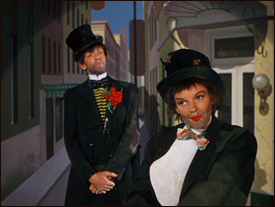 Production
No. 1418 Production
No. 1418
Production dates: November 25, 1947 - March 12, 1948
Release date: July 16, 1948.
Cost: $2,503,654
Gross (in initial release): $6,083,000
CAST:
Judy Garland ... Hannah Brown
Fred Astaire ... Don Hewes
Peter Lawford ... Jonathan Harrow III
Ann Miller ... Nadine Hale
Jules Munshin ... Francois, the Head Waiter
Clinton Sundberg ... Mike, the Bartender
Jeni Le Gon ... Essie
Jimmy Bates ... Boy with Don in toyshop
Richard Beavers ... Leading Man
Dick Simmons ... Al, the Stage Manager
Dee Turnell ... Specialty Dancer
Lola Albright and Joi Lansing ... Showgirls
Wilson Wood ... Marty
Lynn and Jean Romer ... "Delineator" Twins
Peter Chong ... Valet
Nolan Leary ... Drug Clerk
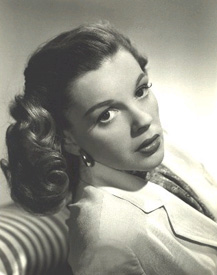 Benay Venuta ... Bar Patron
Benay Venuta ... Bar Patron
Frank Mayo ... Headwaiter
Doris Kemper ... Mary
Hector and His Pals ... Dog Act
William Frawley ... cameo as policeman, uncredited
PRODUCTION
TEAM:
Produced
by: Arthur Freed
Directed by: Charles Walters
Screenplay by: Sidney Shelton, Frances Goodrich and Albert
Hackett
(based on a story by Frances Goodrich and Albert Hackett)
Music and Lyrics by: Irving Berlin
Musical numbers staged and directed by: Robert Alton
Arrangements by: Conrad Salinger, Roger Edens
Conducted by: Johnny Green
Vocal Arrangements: Robert Tucker
Photography: Harry Stradling
Editor: Albert Akst
Art Direction: Cedric Gibbons, Jack Martin Smith
FACTOIDS: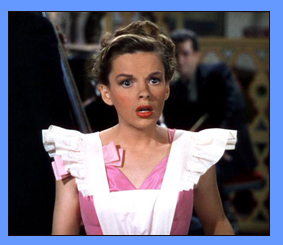
This
was Judy and Fred's only film together. Just after filming
Easter Parade, they went into production for The
Barkley's Of Broadway (1949) but Judy was ill and was
replaced by Ginger Rogers. In 1950, Judy was to replace a
pregnant June Allyson as Fred's partner in Royal Wedding,
but again had to bow out during production due to illness.
She was replaced by Jane Powell. Producer Arthur Freed also
planned to make The Belle Of New York with Judy and
Fred, but that version never went into production. Fred would
make Belle in 1952 with Vera-Ellen as his co-star.
William
Frawley ("Fred Mertz" on I Love Lucy) has
an uncredited bit part in Easter Parade as a policeman.
"Mr. Monotony" was one of Irving Berlin's favorite songs.
After it's deletion from Easter Parade, he tried
to include it in the 1949 Broadway show Miss Liberty
but it didn't make it past the out-of-town tryouts. The same
thing happened when he tried to include it in Ethel Merman's
Broadway hit Call Me Madam (1950). As late as 1989
Sarah Brightman included the song on a Decca Records CD entitled
"The Songs That Got Away", which consisted of little known
songs from Broadway musicals that were either cut or changed
drastically before making it to the Great White Way. That
same year, a variation of Mr. Monotony appeared in Jerome
Robbin's Broadway.
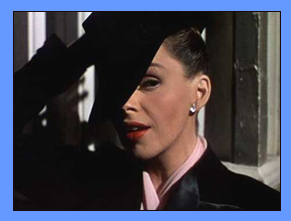 The
idea to have Judy wear the top half of a tuxedo for "Mr.
Monotony" came from husband Vincente Minnelli. He based
it on an outfit worn by Tamara Geva in Broadway's Three's
a Crowd in 1930. The
idea to have Judy wear the top half of a tuxedo for "Mr.
Monotony" came from husband Vincente Minnelli. He based
it on an outfit worn by Tamara Geva in Broadway's Three's
a Crowd in 1930.
Roger
Edens and Johnny Green won the 1948 Academy Award for "MUSIC
(Best Scoring of a Musical Picture)" for Easter Parade.
Their competition was: Lenny Hayton for The Pirate,
Victor Young for The Emperor Waltz, Alfred Newman
for When My Baby Smiles At Me, and Ray Heindorf for
Romance On The High Seas (which, incidentally, Warner
Bros. wanted Judy for the lead but she was too busy at MGM
- so a new Warner's contract player named Doris Day got the
role which started her illustrious career).
The famous Easter Parade shot at the end of the film was filmed
on Lot 3 behind the St. Louis Street, where according to Art
Director Jack Martin Smith there was "an empty, paved area.
I built the lower ten feet of St. Patrick's and one side of
Fifth Avenue for two city Blocks." The right side of the shot
was effectively painted in using the Newcombe process so popular
at the time.
Irving Berlin knew the time period (1912) of the film very
well. He had written songs for the "Ziegfeld Follies
of 1911", and the scores for the "Ziegfeld Follies
of 1919, 1920, & 1927". Berlin received over $600,000
for his work on Easter Parade.
THANK YOU!
A special thanks to Eric Hemphill, Jamin Fowler, and Kim Loeffler
and others for provided many of the images seen in these pages.
Thanks!
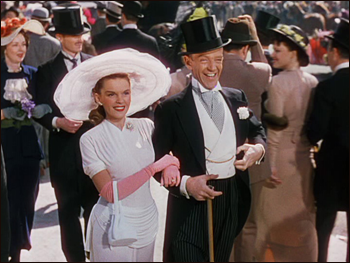
 For even more detailed timelines,
check out Scott Schechter's fantastic book "Judy
Garland The Day-by-Day Chronicle of a Legend."
This book is not a "biography" but exactly
what the title says: A Day-by-Day Chronicle of Judy's
life. With access to the Arthur Freed archives in the
UCLA Library, as well as a multitude of other sources,
Scott picks up where The Judy Room timelines leave off
- and provides even more detailed information than you'll
find here. Nice pictures too. For people who enjoy raw
data this is the book for you! - Click
here to purchase.
For even more detailed timelines,
check out Scott Schechter's fantastic book "Judy
Garland The Day-by-Day Chronicle of a Legend."
This book is not a "biography" but exactly
what the title says: A Day-by-Day Chronicle of Judy's
life. With access to the Arthur Freed archives in the
UCLA Library, as well as a multitude of other sources,
Scott picks up where The Judy Room timelines leave off
- and provides even more detailed information than you'll
find here. Nice pictures too. For people who enjoy raw
data this is the book for you! - Click
here to purchase.
Click here
for more information about Judy Garland books. |
top of page
© The Judy Room
|
|